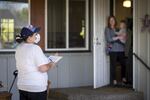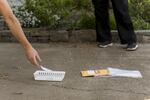Back in March, before the new coronavirus crisis was declared a pandemic, Ben Dalziel spent most of his days in an Oregon State University lab, sequencing genes. He was using the same technology the state lab and others use to test for the virus.
"I would hear news stories of the testing shortage and think, 'There has to be something we can do,’" Dalziel said. “But what?"
The number of confirmed cases of coronavirus in Oregon crossed the 2,000 mark this week. But it’s not known how many cases have been missed. For much of the outbreak, access to testing for COVID-19 was limited to certain people, and many others with mild to moderate symptoms are treating their symptoms at home and not seeking care. A new project, jointly run by Oregon State University and Benton County Health Department, aims to figure out how many people in Corvallis have the disease.
The new study is called TRACE COVID-19, or Team-based Rapid Assessment of Community-level Coronavirus Epidemics. It will be the first survey in the U.S. to track active COVID-19 infections across an entire community and the first to track how that spread changes over time. Dalziel thinks it’s likely their four-week testing period will capture the peak of the current outbreak in Corvallis.

A member of OSU's field team surveys a household for a pilot run of their study. Data taken this day will not be included in the final study, which starts next week.
Karl Maasdam / OSU
TRACE started as a conversation. Dalziel talked to others on campus and heard the same thing: They had the skills and the knowledge to contribute to the study. And the veterinary lab had experience testing for rare diseases.
Dalziel met with prominent scientists across OSU.
“We were discussing the testing shortage and how important testing is in terms of spread and forecasting, and how much better it would be if folks who were infected would know they were infected,” he said.
Related: FAQ: Finding A Vaccine To Beat COVID-19
Dalziel and others recruited several scientists from a wide variety of departments. It was the first time some of them had ever talked to each other.
They started working. The veterinary lab was already talking to the county health department about running a survey, but it soon became clear that it wasn’t just a matter of getting the necessary equipment to test up and running. As research labs, they could run tests on humans as part of a study, but they couldn’t provide anyone they surveyed with test results.
“At first we thought, Well, maybe we can just report back population results, which would still be useful to public health,” Dalziel said, “but it didn’t really feel right to us to ask folks to participate in the study but not be able to inform them themselves.”
Labs need special certifications to be able to diagnose members of the community. It would take too long to get certified, so OSU enlisted Willamette Valley Toxicology to run their tests and report results back to study participants.
Sampling an entire city is close to impossible, so Jeff Bethel, an epidemiologist at OSU and one of the lead investigators on the study, set up what’s called “representative random sampling.” You can’t just randomly sample people or you might end up without a cluster that represents the city, especially if neighborhoods vary in age and diversity.

OSU field staff prepare for a pilot-run of their COVID-19 survey
Karl Maasdam/OSU
Instead, they randomly selected a series of neighborhoods and made sure those neighborhoods represented the demographics of Corvallis. Then, they selected random houses within each neighborhood. Over the course of four weeks, they plan to test about 3,840 Corvallis residents, testing 960 each weekend. And that number should be high enough to track the growth (or decline) of COVID-19 throughout their community.
Samples would be collected from each participant, and the researchers would test them using RT-PCR, which is the most common type of COVID-19 test. It amplifies RNA, which is the genetic material that coronavirus uses, and then binds different colored dyes to each “letter” in the gene. Then, a computer “reads” the sequence by looking at the colored pattern that emerges.
On Saturday, OSU started a trial run of their test, and it went well. But testing thousands of people poses special challenges during a pandemic, Bethel said.
“It’ll be sort of a back-and-forth with the participants,” Bethel said.
Trained nurses will walk up to the door, knock and step back. They’ll talk to participants from a safe distance, then ask them to close the door so the nurses can drop off everything they need, like consent forms. Participants sign the forms and put them outside their doors. Close the door, and the nurses will trade consent forms for tests, and so on. Then they wait, and once the participants have done the test, nurses collect it and continue to the next house.

To maintain social distancing, OSU staff will communicate with study participants from a distance, and leave important forms on the doorstep in baskets.
Karl Maasdam/OSU
“Everyone will be social distancing,” Bethel said. Not just the participants, but “our field team will be social distancing from each other, too.”
They’ll follow up with any study participants who test positive to see if they develop symptoms.
It’s become abundantly clear that there isn’t enough testing in the U.S., primarily caused by a shortage of certain ingredients needed to run RT-PCR tests. So it was very important that, wherever Dalziel and Bethel sourced their kits from, it had to come from outside of that supply chain.
“We didn’t want to be taking tests away from hospitals,” Dalziel said. Right now, supplies to run RT-PCR, which sequences viral RNA or genetic material, are in abundance. It’s the supplies needed to extract and purify the viral RNA that are limited. OSU sourced test kits that are usually used by academics (gene sequencing isn’t just used to look for diseases), but had recently been approved for COVID-19 by the Food and Drug Administration. Those kits used different chemicals than the ones currently preferred by hospitals.
Collecting this data is incredibly important, Dalziel and Bethel said. They’ve both done work modeling disease, and they know that modelers are flying somewhat blind right now.
“The people who are showing symptoms are the ones getting tested now. You can think of that as a biased or nonrepresentative sample of the population because they’re showing symptoms,” Bethel said. And that’s if they can get tested at all. “What we’re trying to figure out is: What’s the percentage of asymptomatic or presymptomatic infection? How many cases are we missing?”
Dalziel agrees. “If we could understand more about how to extract information from those more biased sources of data by pairing it with random samples in the same community, that can help us figure out how to better use those sources,” he said.
It’s particularly important to figure out how many people are asymptomatic or presymptomatic, because there’s increasing evidence that people are most likely to transmit COVID-19 when they first get sick.
Related: Antibody Testing Is Coming To Oregon's Coronavirus Front Lines, With Big Caveats
The hope is that the results of this study can help modelers and epidemiologists figure out how many cases are going undiagnosed, or it can find some number — say, hospitalizations for viral pneumonia — that can serve as a proxy for case counts in under-tested areas. If there are so many hospitalized cases for each case the survey finds in Corvallis, they could estimate or extrapolate from that number.
Eventually, Dalziel and Bethel would like to follow up with an antibody, or serology, study, so they can start to see who has been infected, not just who is infected.
If everything works well, TRACE won’t end with Corvallis, Dalziel said. If any other communities would like to partner with OSU to do their own testing, Dalziel is eager to help, if they can find the funding.
“One of our main goals was to create a playbook that can serve as a template for other studies,” Dalziel said. “How to set up the sampling, how to find supplies that aren’t in the hospital supply chain, everything.”
All the details needed to run the study will be made available to other land-grant universities. No plans are solidified yet, but Dalziel said that there’s definite interest and that others are looking to see how this study goes before starting their own.